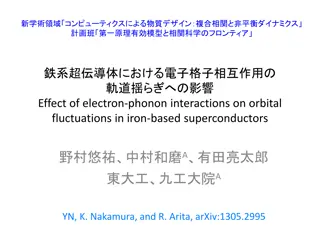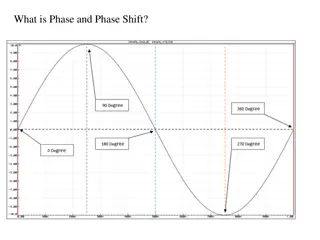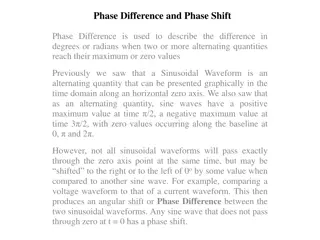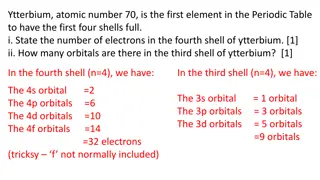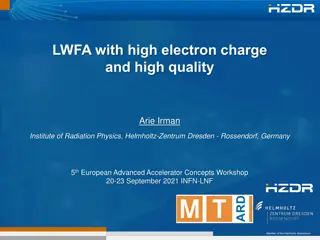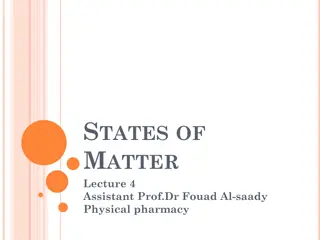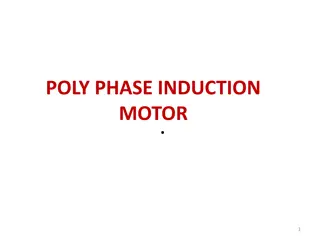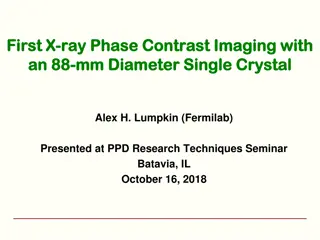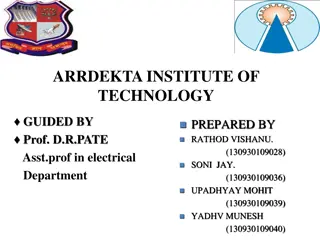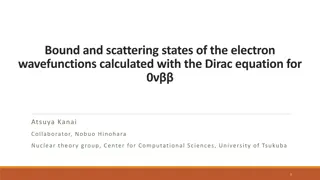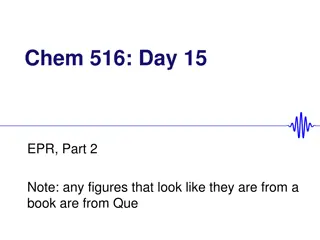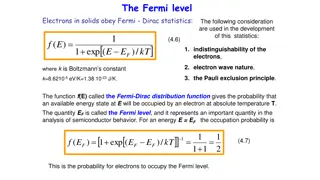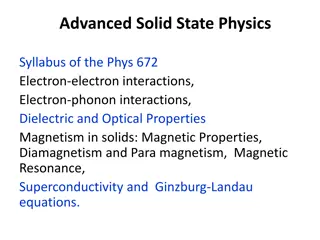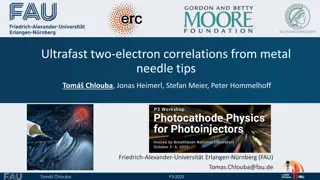Advancements in Single Electron Phase-Space Tracking
Advancements in single electron studies are crucial for beam control and diagnostics in storage rings. Tracking betatron oscillations of a single electron opens up new possibilities for understanding particle dynamics and machine performance. The experimental setup involves using a digital camera and a straight-edge screen to collect data on photon arrival times, providing valuable information for beam manipulation and control concepts.
Download Presentation

Please find below an Image/Link to download the presentation.
The content on the website is provided AS IS for your information and personal use only. It may not be sold, licensed, or shared on other websites without obtaining consent from the author. Download presentation by click this link. If you encounter any issues during the download, it is possible that the publisher has removed the file from their server.
E N D
Presentation Transcript
Single-Electron Phase-Space Tracking Aleksandr Romanov, James Santucci, Giulio Stancari, Alexander Valishev IOTA/FAST collaboration meeting 27 October 2021
Motivation for the single electron studies Observation of a truly point-like object in a storage ring allows proper understanding of a single-particle dynamics Mandatory basis for a successful implementation of advanced beam control concepts Halo and losses suppression Instabilities suppression Higher beam power Valuable machine diagnostics information Betatron and synchrotron dynamics Non-linear dynamics Tune dependence on amplitudes Residual gas properties Validation of simulation tools 2 Aleksandr Romanov | Single-Electron Phase-Space Tracking 27/10/2021
State of the art with a single electron tracking Most studies of a single electron in storage rings were focused on a longitudinal dynamics. Registration of arrival times of individual photons allows tracking of synchrotron oscillations of one or a few electrons. In our previous experiments we used digital cameras to track all 3 mode amplitudes (2 betatron and synchrotron) Capability to track only 2 remaining dynamical variables betatron phases - is necessary for a full 6-dimensional tracking! Therefore, we decided to demonstrate feasibility of a Betatron Oscillations Tracking of a Single Electron (BOPTSE) 3 Aleksandr Romanov | Single-Electron Phase-Space Tracking 10/27/2021
Experimental setup (aka peek-a-boo with an electron) Straight-edge screen is blocking one half of the image Screen is located in the same plane as camera sensor by the 3D-printed attachment Camera is installed on a stack of focusing and transverse stages Transverse position is selected such that the base counting rate of the PMT is reduced by 50% 4 Aleksandr Romanov | Single-Electron Phase-Space Tracking 10/27/2021
Experimental data Described single-pixel detector collects photons from only one half of the phase space Even such a coarse camera can provide information if enough photons is collected Expected detection rate of photons is about 3750 photons per second, or about one per 2000 turns Data from 50us (~180 photons), ideally, would give presented contour plot for the likelihood function: 5 Aleksandr Romanov | Single-Electron Phase-Space Tracking 10/27/2021
Lattice configuration M3L Special lattice was designed with favorable beam parameters: Big horizontal beam size at the M3L observation point Long damping times Zero dispersion in the OSC insertion (aperture restriction) 6 Aleksandr Romanov | Single-Electron Phase-Space Tracking 10/27/2021
Studies timeline 2 hours of access were required to attach the straight-edge screen to the M3L camera and to verify light tightness of the M3L station. Initial commissioning of the data acquisition system were done in the OSC lattice, taking 2 half shifts. Commissioning of a special lattice with long damping times and larger horizontal size Three 8-hour shifts and 4-hour shift (planned: three 8-hour shifts) Taking experimental data in various regimes Two 8-hour shifts (planned: up to four 4-hour shifts) Data and notes taken during the experiment is stored on a shared drive \\beamssrv1.fnal.gov\iota-fast.bd There is a plan to make a peer-reviewed publication to report BOPTSE results 7 Aleksandr Romanov | Single-Electron Phase-Space Tracking 10/27/2021
Main result so far: betatron tune of a single electron! Preliminary analysis confirms groundbreaking potential of the ideas tested with the BOPTSE experiment: For the first time, betatron tune was measured using a single electron in a storage ring The last obstacle on the way towards full 6D tracking of a single particle is proven to be solvable Averaging of likelihood functions from 1268 streaks of 20 photons arrived within 20000 turns Data taking duration: 3 minutes 8 Aleksandr Romanov | Single-Electron Phase-Space Tracking 10/27/2021
Possible complications Tune dependence on the mode amplitudes Chromatic effects from the synchrotron oscillations Can be accounted for because data was taken with a PMT and time of arrival of each photon is available Tune dependance on the betatron amplitudes Images from 3 sensitive cameras were recorded in parallel with PMT measurements, this allows reconstruction of slowly changing betatron amplitudes Other non-linear dynamics from various imperfections and edge fields Hard to account for, since there are too many variables, and the data is too coarse Power supplies ripple Hard to account for, but closed orbit data analysis suggests that biggest ripples have frequency of 10 Hz, which should allow to work with a data streaks of 100-200 photons as if there is no ripple. 9 Aleksandr Romanov | Single-Electron Phase-Space Tracking 10/27/2021
Time of arrival statistics On average, there is about 1 photon per 2000 turns, but since photon-to- photon intervals are random and follow exponential distribution, it is possible to hand-pick photon streaks that are denser than average. With short enough streaks, it is even possible to avoid effects of synchrotron oscillations 10 Aleksandr Romanov | Single-Electron Phase-Space Tracking 10/27/2021
Synchrotron oscillations To account for chromatic effects, synchrotron oscillations were tracked through the entire data set. Chromaticity value was adjusted to maximize likelihood function ~10 s shown 180 s total 11 Aleksandr Romanov | Single-Electron Phase-Space Tracking 10/27/2021
Effect of synchrotron oscillations Within a narrow window of 300 turns, even a simple sin-wave fit gives betatron tune Longer photons streaks require synchrotron oscillations to have visible signal 12 Aleksandr Romanov | Single-Electron Phase-Space Tracking 10/27/2021
Unknown effects When compared to a simulation, it is clear that there are big systematic difference between the used model and the real electron dynamics in the IOTA storage ring 13 Aleksandr Romanov | Single-Electron Phase-Space Tracking 10/27/2021
Instrumentation resonances Due to the fact that only one PMT was used there are algebraic resonance lines in the reconstructed betatron tune if chromatic effects are not included. The most prominent lines are 1/3 and 1/5 and 2/5 On average, for a wrong tune, likelihood function, should be slightly above (??/2 + ??/2) With tune on a resonance , all arrival phases cluster in 3 or 5 groups and it is possible to pick a phase that will match 2 or 3 biggest clusters. 14 Aleksandr Romanov | Single-Electron Phase-Space Tracking 10/27/2021
Chromaticity measurements The used simple tool allows precise measurements of the chromaticity Even preliminary fits give ~10% accuracy 15 Aleksandr Romanov | Single-Electron Phase-Space Tracking 10/27/2021
Amplitude tune dependance During the BOPTSE shift, a classic tune measurements were done for various kick amplitudes BOPTSE data shows that even the smallest kick gives betatron tune that is different from near-zero amplitude tune normally experienced by particles 16 Aleksandr Romanov | Single-Electron Phase-Space Tracking 10/27/2021
Summary BOPTSE experiment demonstrated feasibility of a single electron tracking Even a readily available instruments with small addition allow precision measurements of a true betatron tunes and chromaticities With addition of data from sensitive digital cameras, a precise information about amplitude dependance of betatron tunes can be measured Position sensitive photon detectors will enable an even deeper analysis and understanding of storage rings, which is crucial for successful design, commissioning and operation of future accelerators 17 Aleksandr Romanov | Single-Electron Phase-Space Tracking 10/27/2021





